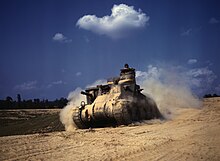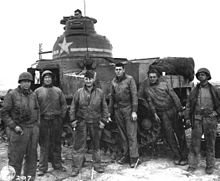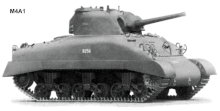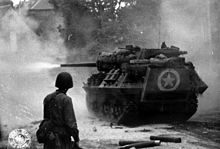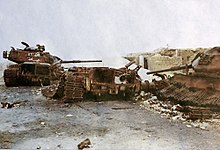Tanks of the United States
Captain Dwight Eisenhower had gone to Camp Meade, Maryland, in February 1918 with the 65th Engineer Regiment, which had been activated to provide the organizational basis for the creation of the Army's first heavy tank battalion.
In March, the 1st Battalion, Heavy Tank Service (as it was then known) was ordered to prepare for movement overseas, and Eisenhower went to New York with the advance party to work out the details of embarkation and shipment with port authorities.
The design was to be carried out by the Ordnance Department, under the job title "Six-ton Special Tractor", and orders for the vehicles placed with private manufacturers.
[citation needed] The Army in France was expecting the first 300 M1917s by April 1918, but by June, production had yet to begin, which forced the US to acquire 144 Renault FTs from the French.
They were met with vigorous opposition to their ideas from senior army officers, who favored the use of armor to support the infantry, not as a separate arm conducting independent operations.
In 1933, MacArthur set the stage for the complete mechanization of the cavalry, declaring "The horse has no higher degree of mobility today than he had a thousand years ago.
[14][15] In mid-1942 a batch was diverted to Australia from the Dutch order where they were used for training[16] After the attack on Pearl Harbor, some of these tanks were taken over by the United States Army and employed in Northern Alaska as the T14 and T16 respectively.
The features of the M2 series development, both good and bad, provided many lessons for U.S. tank designers that were later applied with great success in the M3 Lee, M4 Sherman and many other armored fighting vehicles.
The other major Lend-Lease recipient of the M3, the Soviet Union, was even more dissatisfied with the tank, considering it undergunned, underarmored, likely to catch fire, and too sensitive to fuel quality.
During the remaining struggle for Bataan, the two Tank Battalions tried to defend the beaches, the airfield, and provide support for the infantry, until 8 April 1942, when the 192nd and 194th received orders to prepare to destroy their M3s.
When the American Army joined the North African Campaign in late 1942, Stuart units still formed a large part of its armor strength, until they were eventually replaced with M4 Shermans.
Marmon-Herrington only began to produce significant numbers of the T9 in late 1943 and early 1944, and by then the design was considered to be obsolete; only 830 were built by the time production ended in February 1945.
The M3 was well armed and armored for the period, but due to design flaws (high silhouette, archaic sponson mounting of the main gun, below average offroad performance) it was not satisfactory and was withdrawn from front line duty as soon as the M4 Sherman became available in large numbers, although the British managed to use the M3 successfully against the Imperial Japanese Army in Burma until 1945.
In June–July 1944, the Army accepted a limited run of 254 M4A3E2 Jumbo Shermans, which had very thick armor, and the 75 mm gun in a new, heavier T23-style turret, in order to assault fortifications at Normandy Beach.
In combat it was, unlike the M4 Sherman, fairly equal in firepower and protection to both the Tiger I and Panther tanks, but shared their main faults, underpowered and mechanically unreliable.
The M18 Hellcat (officially designated the "76 mm gun motor carriage M18" or M18 GMC for short) was used in the Italian, European, and Pacific Theaters, and in the Korean War.
Together with the M10 and M18, the 90 mm gun-armed M36 gun motor carriage, provided American and Allied forces with a respectable mobile anti-tank capability against the newer German armored types.
Managing a fighting withdrawal, they ended up as artillery in the Pusan Perimeter; in August reinforcements from the US and the Commonwealth brought heavier tanks that could easily dispatch the T-34s.
[49] The M46 Patton was slower compared to other medium tank counterparts, but its maneuverability and powerful 90 mm gun made it a formidable weapon in the Korean Conflict.
[51] The T48 featured a new turret, an improved suspension, and a redesigned hull in which the drive was to be seated in a centerline position, which also eliminated the bow machine gun as well as its operator.
Firing the gun would often adversely affect the delicate electronics, which were at the early stages of transitioning to solid state, so the missile and guidance system was omitted from vehicles deployed to Vietnam.
[55] The Sheridan was much appreciated by the infantry who were desperate for direct-fire support, which generally served in combination with ACAVs (M113s) as armored cavalry units, consisting of both M113s and M551s as part of their TO&E.
A common field-modification was to mount a large steel shield, known as an "ACAV set" (Armored Cavalry Assault Vehicle), around the commander's .50 caliber (12.7 mm) gun, allowing it to be fired with some level of protection.
Included with the set was an extra layer of steel belly armor which was bolted onto the vehicle's bottom, although only covering from the front to halfway to the end, possibly due to weight reasons.
Consequently, when the M551 Sheridan entered combat in Vietnam in January 1969, it was assigned to strictly cavalry units, and was classified as an Armored Reconnaissance Airborne Assault Vehicle M551 and not a light tank.
Their role was limited by age and light armor to reconnaissance, possibly 6 or fewer Shillelagh missiles were test fired[63] at empty Iraqi bunkers.
The new tank was to be equipped with a number of advanced features such as newly developed "kneeling" hydropneumatic suspension and housing the entire crew in the large turret, and was armed with a 152mm XM150 gun/launcher, which could use conventional ammunition and the Shillelagh missile for long range combat.
The M1A2 was a further improvement, with a commander's independent thermal viewer and weapon station, position navigation equipment, digital data bus and a radio interface unit.
[68] The most lopsided achievement of the M1A1s was the destruction of seven T-72 Lion of Babylon tanks in a point-blank skirmish (less than 50 yards (46 m)) near Mahmoudiyah, about 18 miles (29 km) south of Baghdad, with no losses for the American side.
[69] However, on 29 October 2003, two soldiers were killed and a third wounded when their tank was disabled by an anti-tank mine, which was combined with other explosives (500 kg (1,100 lb), including several 155 mm rounds) to increase its effect.




















